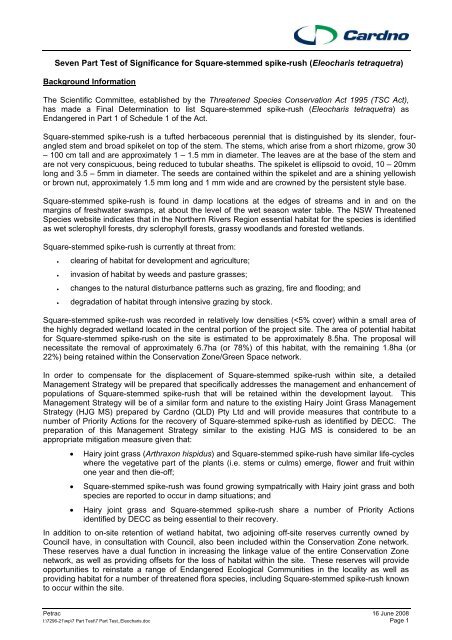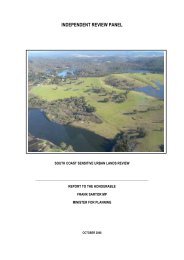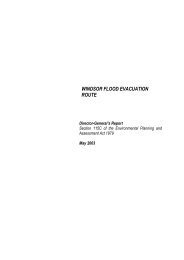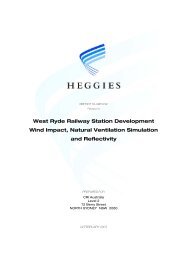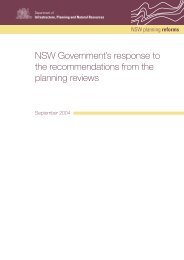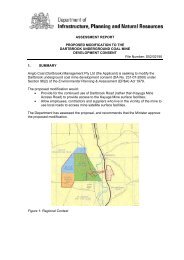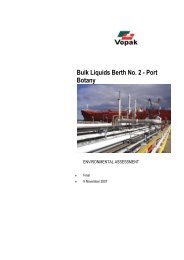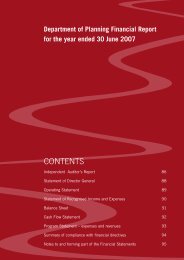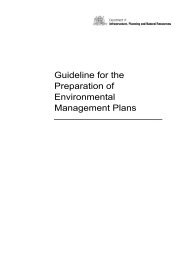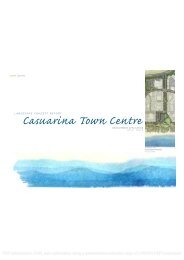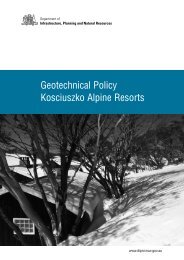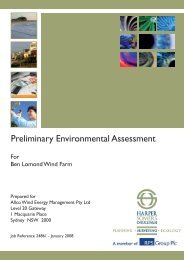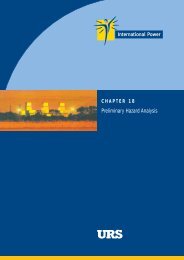Pacific Pines Estate, Lennox Head - Department of Planning
Pacific Pines Estate, Lennox Head - Department of Planning
Pacific Pines Estate, Lennox Head - Department of Planning
Create successful ePaper yourself
Turn your PDF publications into a flip-book with our unique Google optimized e-Paper software.
Seven Part Test <strong>of</strong> Significance for Square-stemmed spike-rush (Eleocharis tetraquetra)<br />
Background Information<br />
The Scientific Committee, established by the Threatened Species Conservation Act 1995 (TSC Act),<br />
has made a Final Determination to list Square-stemmed spike-rush (Eleocharis tetraquetra) as<br />
Endangered in Part 1 <strong>of</strong> Schedule 1 <strong>of</strong> the Act.<br />
Square-stemmed spike-rush is a tufted herbaceous perennial that is distinguished by its slender, fourangled<br />
stem and broad spikelet on top <strong>of</strong> the stem. The stems, which arise from a short rhizome, grow 30<br />
– 100 cm tall and are approximately 1 – 1.5 mm in diameter. The leaves are at the base <strong>of</strong> the stem and<br />
are not very conspicuous, being reduced to tubular sheaths. The spikelet is ellipsoid to ovoid, 10 – 20mm<br />
long and 3.5 – 5mm in diameter. The seeds are contained within the spikelet and are a shining yellowish<br />
or brown nut, approximately 1.5 mm long and 1 mm wide and are crowned by the persistent style base.<br />
Square-stemmed spike-rush is found in damp locations at the edges <strong>of</strong> streams and in and on the<br />
margins <strong>of</strong> freshwater swamps, at about the level <strong>of</strong> the wet season water table. The NSW Threatened<br />
Species website indicates that in the Northern Rivers Region essential habitat for the species is identified<br />
as wet sclerophyll forests, dry sclerophyll forests, grassy woodlands and forested wetlands.<br />
Square-stemmed spike-rush is currently at threat from:<br />
• clearing <strong>of</strong> habitat for development and agriculture;<br />
• invasion <strong>of</strong> habitat by weeds and pasture grasses;<br />
• changes to the natural disturbance patterns such as grazing, fire and flooding; and<br />
• degradation <strong>of</strong> habitat through intensive grazing by stock.<br />
Square-stemmed spike-rush was recorded in relatively low densities (
Seven Part Test <strong>of</strong> Significance<br />
(a) in the case <strong>of</strong> a threatened species, whether the action proposed is likely to have an adverse<br />
effect on the life cycle <strong>of</strong> the species such that a viable local population <strong>of</strong> the species is<br />
likely to be placed at risk <strong>of</strong> extinction<br />
The proposal will necessitate the permanent displacement <strong>of</strong> approximately 6.7ha <strong>of</strong> degraded wetland<br />
within which low abundances <strong>of</strong> Square-stemmed spike-rush have been recorded. The current<br />
management regime (i.e. livestock grazing) does not <strong>of</strong>fer any assurance that the viability <strong>of</strong> Squarestemmed<br />
spike-rush populations within the project site will be sustained in the long-term.<br />
While it is recognised that the in situ extent <strong>of</strong> Square-stemmed spike-rush habitat will be considerably<br />
reduced by the proposed development <strong>of</strong> the site, a main focus <strong>of</strong> the Management Strategy will be the<br />
translocation <strong>of</strong> individuals from the disturbance footprint into similar habitat that will be retained within<br />
the Conservation Zone and within the proposed <strong>of</strong>f-site reserves. Translocation <strong>of</strong> Square-stemmed<br />
spike-rush will coincide with the dormant phase <strong>of</strong> the life-cycle when disturbance to the root system will<br />
have the least impact on the growth and survival <strong>of</strong> individuals. The expected success <strong>of</strong> this<br />
translocation program is bolstered by experimental work conducted on the species by Bell et al (2000),<br />
which indicates that plants are relatively resilient to disturbance events and can be translocated and<br />
grown in pots with a high survival rate.<br />
The survival <strong>of</strong> Square-stemmed spike-rush populations within the on-site Conservation Zone network<br />
and <strong>of</strong>f-site reserves will also be enhanced through:<br />
• the removal <strong>of</strong> cattle from the site, which are currently a source <strong>of</strong> degradation and disturbance<br />
within areas <strong>of</strong> Square-stemmed spike-rush habitat;<br />
• the removal and control <strong>of</strong> weed populations;<br />
• extensive rehabilitation and revegetation works; and<br />
• implementation <strong>of</strong> management regimes that are aimed at threatened species survival and<br />
biodiversity enhancement.<br />
In conclusion, while the proposal will result in the displacement <strong>of</strong> Square-stemmed spike-rush,<br />
appropriate mitigation measures will be implemented to ensure that individuals are retained within<br />
suitable habitat and are able to complete their life-cycle such that populations become self-sustaining.<br />
Implementation <strong>of</strong> an active management regime aimed at retaining and enhancing populations within<br />
suitable habitat within and adjacent to the site <strong>of</strong>fers more security to the long-term survival <strong>of</strong><br />
populations in the <strong>Lennox</strong> <strong>Head</strong> locality than the existing land use and management regime (i.e. livestock<br />
grazing).<br />
The proposal will not result in a viable local population <strong>of</strong> Square-stemmed spike-rush becoming extinct.<br />
(b) in the case <strong>of</strong> an endangered population, whether the action proposed is likely to have an<br />
adverse effect on the life cycle <strong>of</strong> the species that constitutes the endangered population<br />
such that a viable local population <strong>of</strong> the species is likely to be placed at risk <strong>of</strong> extinction,<br />
No consideration under this part <strong>of</strong> the assessment is required.<br />
(c) in the case <strong>of</strong> an endangered ecological community or critically endangered ecological<br />
community, whether the action proposed:<br />
(i) is likely to have an adverse effect on the extent <strong>of</strong> the ecological community such that its<br />
local occurrence is likely to be placed at risk <strong>of</strong> extinction, or<br />
(ii) is likely to substantially and adversely modify the composition <strong>of</strong> the ecological<br />
community such that its local occurrence is likely to be placed at risk <strong>of</strong> extinction,<br />
No consideration under this part <strong>of</strong> the assessment is required.<br />
Petrac 16 June 2008<br />
I:\7296-21\wp\7 Part Test\7 Part Test_Eleocharis.doc Page 2
(d) in relation to the habitat <strong>of</strong> a threatened species, population or ecological community:<br />
(i) the extent to which habitat is likely to be removed or modified as a result <strong>of</strong> the action<br />
proposed, and<br />
As previously established the proposal will necessitate the permanent displacement <strong>of</strong> approximately<br />
6.7ha or 78% <strong>of</strong> Square-stemmed spike-rush habitat within the project site. When assessing the<br />
magnitude <strong>of</strong> the impact the removal <strong>of</strong> 6.7ha <strong>of</strong> habitat will have, the following must be taken into<br />
consideration.<br />
1. Wetland vegetation within the site is currently in a highly degraded state owing to livestock<br />
grazing and weed invasion.<br />
2. Square-stemmed spike-rush was recorded in very low densities (
• extensive revegetation and rehabilitation works will be undertaken within the on-site Conservation<br />
Zones and areas identified as suitable <strong>of</strong>f-site reserves to re-instate the floristic and structural<br />
elements <strong>of</strong> freshwater wetlands with particular emphasis on the provision <strong>of</strong> habitat for Squarestemmed<br />
spike-rush.<br />
(e) whether the action proposed is likely to have an adverse effect on critical habitat (either<br />
directly <strong>of</strong> indirectly),<br />
No areas <strong>of</strong> critical habitat are listed pursuant to the TSC Act as occurring within the site.<br />
Furthermore, the site does not encompass any areas that could, by any objective measure, be<br />
considered critical habitat for Square-stemmed spike-rush.<br />
(f) whether the action proposed is consistent with the objectives or actions <strong>of</strong> a recovery plan<br />
or threat abatement plan,<br />
The overall objective <strong>of</strong> the Recovery Plan prepared for Square-stemmed spike-rush by the New South<br />
Wales National Parks and Wildlife Service (NPWS) is to maintain viable populations <strong>of</strong> Square-stemmed<br />
spike-rush in the long term.<br />
The Management Strategy that will be prepared for Square-stemmed spike-rush will be consistent with<br />
the overall objective <strong>of</strong> the recovery plan prepared for Square-stemmed spike-rush as:<br />
• a representative and sustainable proportion <strong>of</strong> the site’s degraded Square-stemmed spike-rush<br />
habitat will be preserved and enhanced within the Conservation Zone/Green Space network;<br />
• connectivity between retained wetland within the development layout and surrounding areas will<br />
be provided through the Conservation Zone/Green Space network;<br />
• where environmentally sensitive areas are not included within the Conservation Zone/Green<br />
Space network, appropriate <strong>of</strong>fsets shall be provided in the form <strong>of</strong> on-site compensatory habitat<br />
and <strong>of</strong>f-site reserves;<br />
• areas included within the Conservation Zone/Green Space network and <strong>of</strong>f-site reserves will be<br />
rehabilitated and managed in a manner that re-instates the ecological values and functions <strong>of</strong> the<br />
degraded habitat and ensures the long-term viability <strong>of</strong> Square-stemmed spike-rush in the<br />
locality; and<br />
• human induced threats (i.e. stock, weed incursion, inappropriate mowing regimes and etc) will be<br />
removed or suitably managed.<br />
(g) whether the action proposed constitutes or is part <strong>of</strong> a key threatening process or is likely<br />
to result in the operation <strong>of</strong>, or increase the impact <strong>of</strong>, a key threatening process.<br />
A threatening process is identified under the TSC Act as a process that threatens, or may have the<br />
capability to threaten, the survival or evolutionary development <strong>of</strong> species, populations or communities.<br />
The current list <strong>of</strong> key threatening processes under the TSC Act, and whether the proposed development<br />
is recognised as a threatening process is shown below.<br />
Petrac 16 June 2008<br />
I:\7296-21\wp\7 Part Test\7 Part Test_Eleocharis.doc Page 4
Listed Key Threatening Process (as described in the final<br />
determination <strong>of</strong> the Scientific Committee to list the threatening<br />
process)<br />
Is the development or activity<br />
proposed <strong>of</strong> a class <strong>of</strong><br />
development or activity that is<br />
recognised as a threatening<br />
process?<br />
Likely Possible Unlikely<br />
Invasion and establishment <strong>of</strong> exotic vines and scramblers √<br />
Invasion <strong>of</strong> native plant communities by bitou bush & boneseed √<br />
Invasion <strong>of</strong> native plant communities by exotic perennial grasses √<br />
Invasion, establishment and spread <strong>of</strong> Lantana camara √<br />
Competition and grazing by the feral European rabbit √<br />
Competition and habitat degradation by feral goats √<br />
Competition from feral honeybees √<br />
Herbivory and environmental degradation caused by feral deer √<br />
Importation <strong>of</strong> red imported fire ants into NSW √<br />
Introduction <strong>of</strong> the large earth bumblebee (Bombus terrestris) √<br />
Invasion and establishment <strong>of</strong> the Cane Toad √<br />
Invasion <strong>of</strong> the yellow crazy ant (Anoplolepis gracilipes) √<br />
Predation by feral cats √<br />
Predation by the European Red Fox √<br />
Predation by the Plague Minnow (Gambusia holbrooki) √<br />
Predation by the ship rat (Rattus rattus) on Lord Howe Island √<br />
Predation, habitat degradation, competition and disease transmission by<br />
Feral Pigs (Sus scr<strong>of</strong>a)<br />
Alteration to the natural flow regimes <strong>of</strong> rivers, streams, floodplains &<br />
wetlands.<br />
Bushrock Removal √<br />
Clearing <strong>of</strong> native vegetation √<br />
Alteration <strong>of</strong> habitat following subsidence due to longwall mining √<br />
Ecological consequences <strong>of</strong> high frequency fires √<br />
Human-caused Climate Change √<br />
Loss and/or degradation <strong>of</strong> sites used for hill-topping by butterflies √<br />
Loss <strong>of</strong> Hollow-bearing Trees - key threatening process √<br />
Removal <strong>of</strong> dead wood and dead trees √<br />
Infection by Psittacine circoviral (beak & feather) disease affecting<br />
endangered psittacine species<br />
Infection <strong>of</strong> frogs by amphibian chytrid fungus causing the disease<br />
chytridiomycosis<br />
Infection <strong>of</strong> native plants by Phytophthora cinnamomi √<br />
Death or injury to marine species following capture in shark control<br />
programs on ocean beaches<br />
Entanglement in, or ingestion <strong>of</strong> anthropogenic debris in marine and<br />
estuarine environments<br />
With regard to the above, ‘clearing <strong>of</strong> native vegetation’ is a threatening process listed under the TSC<br />
Act. Clearing is defined as the destruction <strong>of</strong> a sufficient proportion <strong>of</strong> one or more strata (layers) within a<br />
stand or stands <strong>of</strong> native vegetation so as to result in the loss, or long term modification <strong>of</strong> the structure,<br />
composition and ecological function <strong>of</strong> a stand or stands. The proposal will necessitate the clearance <strong>of</strong><br />
Petrac 16 June 2008<br />
I:\7296-21\wp\7 Part Test\7 Part Test_Eleocharis.doc Page 5<br />
√<br />
√<br />
√<br />
√<br />
√<br />
√
approximately 6.7ha (78%) <strong>of</strong> degraded wetland vegetation, which currently supports patches <strong>of</strong> Squarestemmed<br />
spike-rush at very low densities (i.e. less than 5% cover). The clearance <strong>of</strong> this vegetation will<br />
be compensated for by:<br />
• on-site retention and enhancement <strong>of</strong> 1.8ha (or 22%) <strong>of</strong> retained wetland vegetation within the<br />
Conservation Zone network; and<br />
• the establishment <strong>of</strong> <strong>of</strong>f-site reserves that have a dual function in increasing the connectivity<br />
values <strong>of</strong> the entire Conservation Zone/Green Space network, as well as providing <strong>of</strong>fsets for the<br />
displacement <strong>of</strong> Square-stemmed spike-rush habitat within the site.<br />
‘Alteration to natural flow regimes’ can occur through reducing or increasing flows, altering seasonality <strong>of</strong><br />
flows, changing the frequency, duration, magnitude, timing, predictability and variability <strong>of</strong> flow events,<br />
altering surface and subsurface water levels and changing the rate <strong>of</strong> rise or fall <strong>of</strong> water levels (DEC<br />
2004).<br />
The hydrology <strong>of</strong> wetland habitat retained within the development layout area will not be significantly<br />
altered from the existing situation. Any changes will involve increased short term flood depths<br />
upstream <strong>of</strong> the two proposed constructed weirs and slightly increased flood flow velocities over these<br />
weirs in some storm events. These weirs will only function during storm events, causing water to be<br />
stored at a greater depth than is currently the case. Water flow velocities remain largely unchanged<br />
because weirs have low flow bypasses to mimic existing stream flow outside <strong>of</strong> storm events. During<br />
flood events, the detention effects provide the same peak flow discharges as the existing situation at<br />
slightly increased velocities. Therefore, the impact on retained wetland is that there will be a greater<br />
depth <strong>of</strong> water in the area during a storm event. It is not envisaged that an increase in the depth <strong>of</strong><br />
water during a storm event will have an adverse impact on retained populations <strong>of</strong> Square-stemmed<br />
spike-rush<br />
Conclusion<br />
Given the above facts and circumstances, the proposed development will not have a significant impact<br />
on the ongoing viability <strong>of</strong> Square-stemmed spike-rush in the locality as:<br />
• 22% <strong>of</strong> the potential Square-stemmed spike-rush habitat located on the site will be retained and<br />
rehabilitated with the Conservation Zone/Green Space network;<br />
• appropriate <strong>of</strong>f-site reserves have been identified and negotiations are in place to secure this land<br />
biodiversity conservation purposes;<br />
• proposed on-site mitigation measures will enhance retained populations within the development<br />
layout;<br />
• the proposed Conservation Zone/Green Space network will provide connectivity between the<br />
known Square-stemmed spike-rush population within the site and areas <strong>of</strong> suitable habitat within<br />
and adjacent to the site; and<br />
• contributions will be made through the implementation <strong>of</strong> a Square-stemmed spike-rush<br />
Management Strategy, to a number <strong>of</strong> the Priority Actions identified by DECC for the recovery <strong>of</strong><br />
Square-stemmed spike-rush.<br />
References<br />
Bell, D., Campbell, M. L. and Bruhl, J. J. (2000) Population dynamics and disturbance regime <strong>of</strong> the<br />
threatened plant Square-stemmed spike-rush Eleocharis tetraquetra Nees. Technical Report to the<br />
NSW National Parks and Wildlife Service. University <strong>of</strong> New England, Armidale NSW.<br />
<strong>Department</strong> <strong>of</strong> Environment and Climate Change (last updated 1 st September 2005). Square-stemmed<br />
Spike-rush (Eleocharis tetraquetra) Endangered Species Determination.<br />
http://www.threatenedspecies.environment.nsw.gov.au/tspr<strong>of</strong>ile/pr<strong>of</strong>ile.aspx?id=10265<br />
Accessed 11 th June 2008<br />
Petrac 16 June 2008<br />
I:\7296-21\wp\7 Part Test\7 Part Test_Eleocharis.doc Page 6
New South Wales National Parks and Wildlife Service (2004). Alteration to the natural flow regimes <strong>of</strong><br />
rivers, streams, floodplains & wetlands - key threatening process listing<br />
http://www.environment.nsw.gov.au/threatenedspecies/AlterationNaturalFlowKTPListing.htm<br />
New South Wales National Parks and Wildlife Service (1999). Square-stemmed spike-rush Eleocharis<br />
tetraquetra Nees – Approved Recovery Plan.<br />
http://www2.nationalparks.nsw.gov.au/PDFs/Eleoch.pdf<br />
Petrac 16 June 2008<br />
I:\7296-21\wp\7 Part Test\7 Part Test_Eleocharis.doc Page 7
Seven Part Test <strong>of</strong> Significance for Freshwater wetlands on coastal floodplains <strong>of</strong> the NSW<br />
North Coast, Sydney Basin and South East Corner bioregions<br />
Background Information<br />
The Scientific Committee, established by the Threatened Species Conservation Act 1995 (TSC Act),<br />
has made a Final Determination to list Freshwater wetlands on coastal floodplains <strong>of</strong> the NSW North<br />
Coast, Sydney Basin and South East Corner bioregions as an Endangered Ecological Community in<br />
Part 3 <strong>of</strong> Schedule 1 <strong>of</strong> the Act.<br />
Freshwater Wetlands on Coastal Floodplains Endangered Ecological Community (FWCF EEC) are<br />
associated with coastal areas subject to periodic flooding and in which standing fresh water persists for<br />
at least part <strong>of</strong> the year in most years. FWCF EEC typically occurs on silts, muds or humic loams in<br />
low-lying parts <strong>of</strong> floodplains, alluvial flats, depressions, drainage lines, backswamps, lagoons and<br />
lakes but may also occur in backbarrier landforms where floodplains adjoin coastal sandplains.<br />
Representations <strong>of</strong> FWCF EEC generally occur below 20 m elevation on level areas and are dominated<br />
by herbaceous plants and have very few woody species. The structure and composition <strong>of</strong> the<br />
community varies both spatially and temporally depending on the water regime. Structure and species<br />
can also be altered by grazing history, changes to drainage regime, soil salinity and catchment run <strong>of</strong>f,<br />
and <strong>of</strong>ten disturbed areas <strong>of</strong> FWCF EECs support a substantial proportion <strong>of</strong> exotic flora species.<br />
FWCF EEC is identified as being at threat from:<br />
• Land clearing<br />
• Continuing fragmentation and degradation<br />
• Flood mitigation and drainage works<br />
• Filling associated with urban and industrial development<br />
• Pollution and eutrophication from urban and agricultural run<strong>of</strong>f<br />
• Weed invasion<br />
• Overgrazing, trampling by livestock<br />
• Soil disturbance by pigs<br />
• Activation <strong>of</strong> acid sulfate soils<br />
• Dumping <strong>of</strong> landfill, rubbish and garden refuse<br />
• Native fauna is threatened by predation, particularly by mosquito fish and cane toads<br />
• Anthropogenic climate change<br />
The project site supports approximately 4.2ha <strong>of</strong> vegetation that is considered to support elements <strong>of</strong><br />
FWCF EEC. At present, areas <strong>of</strong> FWCF EEC within the site are in a highly degraded state owing to a<br />
history <strong>of</strong> livestock grazing and on-going weed invasion. Nonetheless, two threatened flora species<br />
were recorded within areas identified as supporting FWCF EEC, namely Hairy Joint Grass (Arthraxon<br />
hispidus) and Square-stemmed spike rush (Eleocharis tetraquetra) 1 . The current management regime<br />
for the site (i.e. livestock production) does not afford any protection for areas <strong>of</strong> FWCF EEC identified<br />
within the site and has substantially contributed to the degraded nature <strong>of</strong> the site’s vegetation. While it<br />
is recognised that the proposal will necessitate the removal <strong>of</strong> approximately 2.6ha <strong>of</strong> FWCF EEC<br />
within the site, the remaining 1.4ha (or 33%) will be retained and protected within the Conservation<br />
Zone/Green Space network. Additional <strong>of</strong>fsets for the displacement <strong>of</strong> the site’s degraded FWCF EEC<br />
are provided through the establishment <strong>of</strong> two <strong>of</strong>f-site reserve systems, which have also been included<br />
within the Conservation Zone network. These reserves have a dual function in increasing the linkage<br />
value <strong>of</strong> the entire Conservation Zone network, as well as providing <strong>of</strong>fsets for the loss <strong>of</strong> habitat within<br />
the site. These reserves will provide opportunities to reinstate a range <strong>of</strong> Endangered Ecological<br />
Communities in the locality as well as providing habitat for a number <strong>of</strong> threatened flora species known<br />
to occur within the site.<br />
1<br />
Separate Seven Part Tests have been completed for each <strong>of</strong> these flora species.<br />
Petrac 16 June 2008<br />
I:\7296-21\wp\7 Part Test\7 Part Test_FWCF.doc Page 1
Seven Part Test for Significance<br />
(a) in the case <strong>of</strong> a threatened species, whether the action proposed is likely to have an<br />
adverse effect on the life cycle <strong>of</strong> the species such that a viable local population <strong>of</strong> the<br />
species is likely to be placed at risk <strong>of</strong> extinction,<br />
No consideration under this part <strong>of</strong> the assessment is required.<br />
(b) in the case <strong>of</strong> an endangered population, whether the action proposed is likely to have an<br />
adverse effect on the life cycle <strong>of</strong> the species that constitutes the endangered population<br />
such that a viable local population <strong>of</strong> the species is likely to be placed at risk <strong>of</strong> extinction,<br />
No consideration under this part <strong>of</strong> the assessment is required.<br />
(c) in the case <strong>of</strong> an endangered ecological community or critically endangered ecological<br />
community, whether the action proposed:<br />
(i) is likely to have an adverse effect on the extent <strong>of</strong> the ecological community such that its<br />
local occurrence is likely to be placed at risk <strong>of</strong> extinction, or<br />
(ii) is likely to substantially and adversely modify the composition <strong>of</strong> the ecological<br />
community such that its local occurrence is likely to be placed at risk <strong>of</strong> extinction,<br />
The removal <strong>of</strong> 2.6ha <strong>of</strong> wetland vegetation within the site identified as supporting elements <strong>of</strong> FWCF<br />
EEC will not place the occurrence <strong>of</strong> FWCF EEC in the <strong>Lennox</strong> <strong>Head</strong> locality at risk <strong>of</strong> extinction given<br />
the following.<br />
1. Areas identified as supporting FWCF EEC within the site are in a highly degraded state and<br />
exotic species were found to constitute 46% <strong>of</strong> the species composition.<br />
2. The site’s degraded wetland communities have low connectivity values and only link to<br />
surrounding native vegetation (i.e. SEPP 14 wetland to the west) via the maintained grassland<br />
associated with the water quality control pond on one compass quarter (refer connectivity<br />
estimation methodology provided in Gibbons et al. 2005).<br />
3. Visual inspection <strong>of</strong> aerial photography indicates that similar communities, namely degraded<br />
drainage lines and damp depressions in grazed paddocks are widespread throughout the <strong>Lennox</strong><br />
<strong>Head</strong> locality.<br />
4. The site’s degraded wetlands were not recommended to be zoned for Environmental Protection<br />
during a review conducted in 2000 into the adequacy and suitability <strong>of</strong> the zoning provided in the<br />
BLEP (refer <strong>Lennox</strong> <strong>Head</strong> Structure Plan 2004).<br />
5. The Environmental Protection Zone review also states that sedgelands and rushland habitats are<br />
typically well represented in the existing Environmental Protection Zones (refer <strong>Lennox</strong> <strong>Head</strong><br />
Structure Plan 2004).<br />
Given the above facts it is determined that the proposed development will not have an adverse affect<br />
on the extent <strong>of</strong> the ecological community nor adversely modify the composition <strong>of</strong> the ecological<br />
community such that its local occurrence is likely to be placed at risk <strong>of</strong> extinction<br />
(d) in relation to the habitat <strong>of</strong> a threatened species, population or ecological community:<br />
(i) the extent to which habitat is likely to be removed or modified as a result <strong>of</strong> the action<br />
proposed, and<br />
The proposal will necessitate the removal <strong>of</strong> approximately 2.6ha (or 67%) <strong>of</strong> highly degraded FWCF<br />
EEC within the site. Compensation for the loss <strong>of</strong> this habitat will be provided through:<br />
Petrac 16 June 2008<br />
I:\7296-21\wp\7 Part Test\7 Part Test_FWCF.doc Page 2
• the removal <strong>of</strong> livestock, which are currently a major source <strong>of</strong> degradation and disturbance<br />
within the site’s wetland areas<br />
• extensive revegetation and rehabilitation works to be undertaken within on-site Conservation<br />
Zones;<br />
• extensive revegetation and rehabilitation works within suitable areas <strong>of</strong> <strong>of</strong>f-site reserves (refer<br />
Conceptual Rehabilitation Plan prepared by Cardno and dated 29 th May 2008) to re-instate the<br />
floristic and structural elements <strong>of</strong> freshwater wetlands; and<br />
• implementation <strong>of</strong> management regimes that are focussed on biodiversity conservation, including<br />
the conservation <strong>of</strong> threatened flora species recorded within the site’s wetland vegetation (i.e.<br />
Hairy joint grass and Square-stemmed spike rush).<br />
ii) whether an area <strong>of</strong> habitat is likely to become fragmented or isolated from other areas <strong>of</strong><br />
habitat as a result <strong>of</strong> the proposed action, and<br />
The FWCF EEC located on the site is highly degraded and currently surrounded by expanses <strong>of</strong> cleared<br />
grassland and existing urban development.<br />
Using the criteria set out by Gibbons et al (2005), the freshwater wetlands within the site are considered<br />
to have nil – low connectivity value given:<br />
• the vegetation is in a reasonably low condition (Gibbons et al [2005] consider grasslands where<br />
(g) whether the action proposed constitutes or is part <strong>of</strong> a key threatening process or is likely<br />
to result in the operation <strong>of</strong>, or increase the impact <strong>of</strong>, a key threatening process.<br />
A threatening process is identified under the TSC Act as a process that threatens, or may have the<br />
capability to threaten, the survival or evolutionary development <strong>of</strong> species, populations or communities.<br />
The current list <strong>of</strong> key threatening processes under the TSC Act, and whether the proposed development<br />
is recognised as a threatening process is shown below.<br />
Listed Key Threatening Process (as described in the final determination<br />
<strong>of</strong> the Scientific Committee to list the threatening process)<br />
Is the development or activity<br />
proposed <strong>of</strong> a class <strong>of</strong><br />
development or activity that is<br />
recognised as a threatening<br />
process?<br />
Likely Possible Unlikely<br />
Invasion and establishment <strong>of</strong> exotic vines and scramblers √<br />
Invasion <strong>of</strong> native plant communities by bitou bush & boneseed √<br />
Invasion <strong>of</strong> native plant communities by exotic perennial grasses √<br />
Invasion, establishment and spread <strong>of</strong> Lantana camara √<br />
Competition and grazing by the feral European rabbit √<br />
Competition and habitat degradation by feral goats √<br />
Competition from feral honeybees √<br />
Herbivory and environmental degradation caused by feral deer √<br />
Importation <strong>of</strong> red imported fire ants into NSW √<br />
Introduction <strong>of</strong> the large earth bumblebee (Bombus terrestris) √<br />
Invasion and establishment <strong>of</strong> the Cane Toad √<br />
Invasion <strong>of</strong> the yellow crazy ant (Anoplolepis gracilipes) √<br />
Predation by feral cats √<br />
Predation by the European Red Fox √<br />
Predation by the Plague Minnow (Gambusia holbrooki) √<br />
Predation by the ship rat (Rattus rattus) on Lord Howe Island √<br />
Predation, habitat degradation, competition and disease transmission by Feral<br />
Pigs (Sus scr<strong>of</strong>a)<br />
Alteration to the natural flow regimes <strong>of</strong> rivers, streams, floodplains & wetlands. √<br />
Bushrock Removal √<br />
Clearing <strong>of</strong> native vegetation √<br />
Alteration <strong>of</strong> habitat following subsidence due to longwall mining √<br />
Ecological consequences <strong>of</strong> high frequency fires √<br />
Human-caused Climate Change √<br />
Loss and/or degradation <strong>of</strong> sites used for hill-topping by butterflies √<br />
Loss <strong>of</strong> Hollow-bearing Trees - key threatening process √<br />
Removal <strong>of</strong> dead wood and dead trees √<br />
Infection by Psittacine circoviral (beak & feather) disease affecting endangered<br />
psittacine species<br />
Infection <strong>of</strong> frogs by amphibian chytrid fungus causing the disease<br />
chytridiomycosis<br />
Infection <strong>of</strong> native plants by Phytophthora cinnamomi √<br />
Death or injury to marine species following capture in shark control programs<br />
on ocean beaches<br />
Petrac 16 June 2008<br />
I:\7296-21\wp\7 Part Test\7 Part Test_FWCF.doc Page 4<br />
√<br />
√<br />
√<br />
√
Entanglement in, or ingestion <strong>of</strong> anthropogenic debris in marine and estuarine<br />
environments<br />
With regard to the above, ‘clearing <strong>of</strong> native vegetation’ is a threatening process listed under the TSC<br />
Act. Clearing is defined as the destruction <strong>of</strong> a sufficient proportion <strong>of</strong> one or more strata (layers) within a<br />
stand or stands <strong>of</strong> native vegetation so as to result in the loss, or long term modification <strong>of</strong> the structure,<br />
composition and ecological function <strong>of</strong> a stand or stands. The proposal will necessitate the clearance <strong>of</strong><br />
approximately 2.6ha (67%) <strong>of</strong> degraded wetland vegetation, which is only marginally dominated by native<br />
plants species (i.e. 46% <strong>of</strong> species were found to be exotic or introduced). The clearance <strong>of</strong> this<br />
vegetation will be compensated for by:<br />
• on-site retention and enhancement <strong>of</strong> 1.4 ha (or 33%) <strong>of</strong> retained wetland vegetation within the<br />
Conservation Zone network; and<br />
• the establishment <strong>of</strong> <strong>of</strong>f-site reserves that have a dual function in increasing the connectivity<br />
values <strong>of</strong> the entire Conservation Zone/Green Space network, as well as providing <strong>of</strong>fsets for the<br />
loss <strong>of</strong> FWCF EEC and other habitat within the site.<br />
‘Alteration to natural flow regimes’ can occur through reducing or increasing flows, altering seasonality <strong>of</strong><br />
flows, changing the frequency, duration, magnitude, timing, predictability and variability <strong>of</strong> flow events,<br />
altering surface and subsurface water levels and changing the rate <strong>of</strong> rise or fall <strong>of</strong> water levels (DECC<br />
2004).<br />
The hydrology <strong>of</strong> wetland habitat retained within the development layout area will not be significantly<br />
altered from the existing situation. Any changes will involve increased short term flood depths<br />
upstream <strong>of</strong> the two proposed constructed weirs and slightly increased flood flow velocities over these<br />
weirs in some storm events. These weirs will only function during storm events, causing water to be<br />
stored at a greater depth than is currently the case. Water flow velocities remain largely unchanged<br />
because weirs have low flow bypasses to mimic existing stream flow outside <strong>of</strong> storm events. During<br />
flood events, the detention effects provide the same peak flow discharges as the existing situation at<br />
slightly increased velocities. Overall, the impact on retained wetland is that there will be a greater depth<br />
<strong>of</strong> water in the area during a storm event. It is not envisaged that an increase in the depth <strong>of</strong> water<br />
during a storm event will have an adverse impact on the retained wetland community.<br />
Conclusion<br />
With regard to the above facts and circumstances, the proposal will result in the clearance <strong>of</strong><br />
approximately 2.6ha <strong>of</strong> degraded wetland vegetation considered to support elements <strong>of</strong> the FWCF EEC.<br />
However, the proposal will not have a significant impact on the long-term viability <strong>of</strong> this EEC in the<br />
<strong>Lennox</strong> <strong>Head</strong> region given that:<br />
• the FWCF on the site is in a highly degraded state and has low connectivity value;<br />
• similar representations <strong>of</strong> this community are relatively widespread throughout the locality and<br />
are not exclusive to the site alone;<br />
• the proposal provides the retention <strong>of</strong> approximately 1.4ha (or 33%) <strong>of</strong> this community within the<br />
Conservation Zone/Green Space network;<br />
• extensive revegetation and rehabilitation works will be undertaken within the on-site Conservation<br />
Zones and areas identified as suitable <strong>of</strong>f-site reserves to re-instate the floristic and structural<br />
elements <strong>of</strong> freshwater wetlands with particular emphasis on the provision <strong>of</strong> habitat for Hairy<br />
joint grass and Square-stemmed spike rush; and<br />
• active management <strong>of</strong> FWCF EEC retained within the Conservation Zone network and <strong>of</strong>f-site<br />
reserves will provide for the long-term survival <strong>of</strong> FWCF EEC within and adjacent to the site more<br />
so than existing scenario (i.e. exposure to livestock grazing and weed invasion).<br />
Petrac 16 June 2008<br />
I:\7296-21\wp\7 Part Test\7 Part Test_FWCF.doc Page 5<br />
√
References<br />
<strong>Department</strong> <strong>of</strong> Environment and Climate Change (last updated 1 st September 2005). Freshwater<br />
wetlands on coastal floodplains <strong>of</strong> the NSW North Coast, Sydney Basin and South East Corner<br />
bioregions as Endangered Ecological Communities – Endangered Ecological Community Determination.<br />
Gibbons, P., Ayers, D., Seddon, J., Doyle, S. and Briggs, S. (2005) Biometric Version 1.8 A Terrestrial<br />
Biodiversity Assessment Tool for the NSW Property Vegetation Plan Developer Operational Manual<br />
NSW <strong>Department</strong> <strong>of</strong> Environment and Conservation.<br />
http://www.threatenedspecies.environment.nsw.gov.au/tspr<strong>of</strong>ile/pr<strong>of</strong>ile.aspx?id=10929<br />
Accessed 11 th June 2008<br />
New South Wales National Parks and Wildlife Service (2004). Alteration to the natural flow regimes <strong>of</strong><br />
rivers, streams, floodplains & wetlands - key threatening process listing<br />
http://www.environment.nsw.gov.au/threatenedspecies/AlterationNaturalFlowKTPListing.htm<br />
Petrac 16 June 2008<br />
I:\7296-21\wp\7 Part Test\7 Part Test_FWCF.doc Page 6


